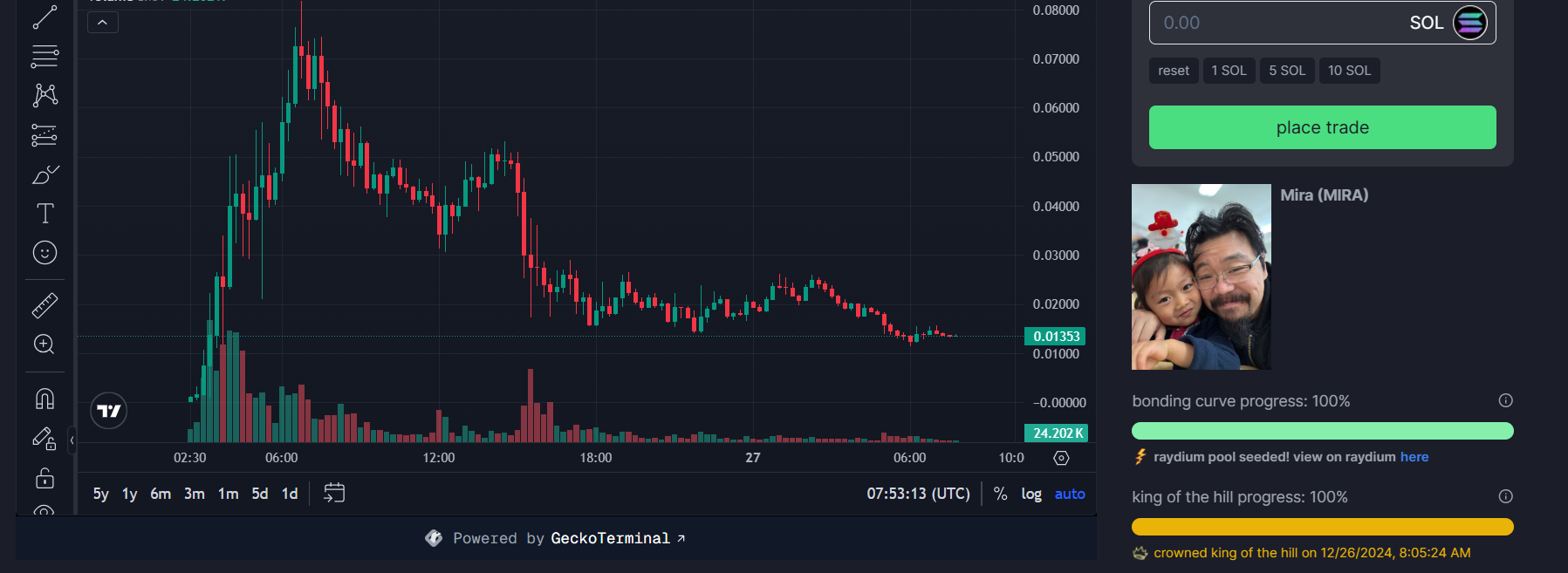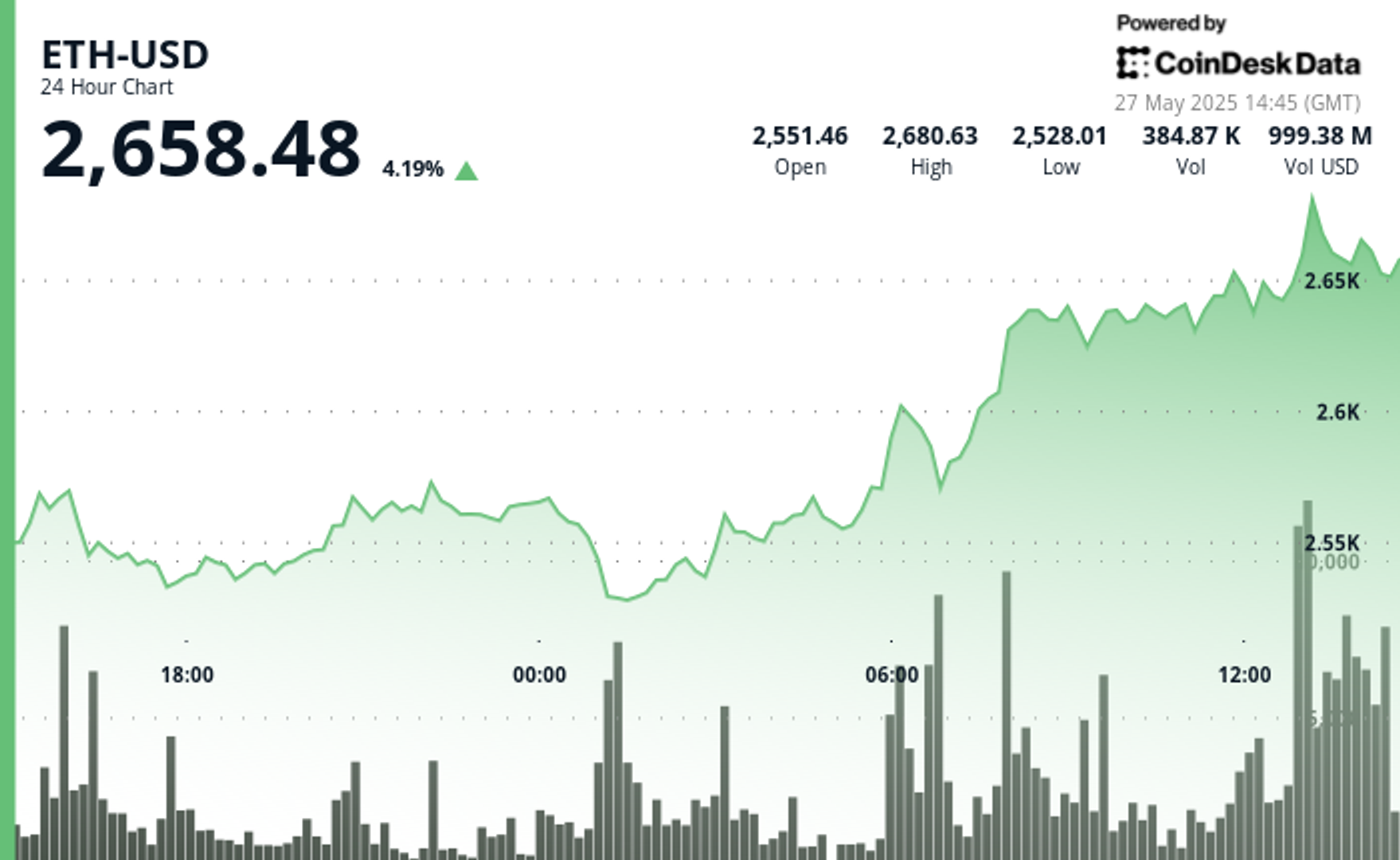Uncategorized
Memecoin Degens Raise Millions for Rare Cancer Research After a Father’s Plea

A Pump.Fun memecoin zoomed from zero to an $80 million market capitalization on Thursday after a father’s plea for donations into a research study for his daughter’s rare brain cancer attracted swathes of crypto traders.
The token’s prices have since fallen 80% since a Thursday peak and trade at just over a cent as of Friday. But while late buyers are sitting on losses, the effort still raised over $1 million for the cause.
In an X post on Thursday, Runaway founder Siqi Chen said his daughter Mira was diagnosed with a type of brain tumor in September and that research and funding had “been lacking” because of how rare the condition was.
His GoFundMe page has raised 80% of its $300,000 target as of Thursday, with all proceeds going directly to research efforts at the Hankinson Lab at the Univerity of Colorado.
Chen also posted his Ethereum wallet on the X thread after user demand, later putting his Solana and Bitcoin addresses as users asked for more options.
And then Pump.Fun happened.
The platform lets anyone issue a token for less than $2 in capital, after which they choose the number of tokens, theme, and meme picture to accompany it. When the market capitalization of any token reaches $69,000, a portion of liquidity is deposited to the Solana-based exchange Raydium and burned.

A user created the MIRA token attached with a picture of Chen and his daughter, with no apparent objective except it being a token that can be traded just like any other memecoin. The user’s Pump.Fun profile shows MIRA was just one of the several tokens they created that day, with all the others failing to break a $6,000 market cap.
X user @Waddles_eth later purchased 50% of the supply and sent all of it to Chen, who boosted the memecoin on his X account.
That ensured virality for the token and sent prices from fractions of a penny to a peak of 8 cents early Thursday. The value of Chen’s token holdings went from $400,000 to over $18 million as the token went viral. It attracted a peak of $7 million in liquidity (worth in both Solana’s SOL and the memecoin) as the market became widely traded.
It attracted over $85 million in trading volumes and over 130,000 transactions, making it the most popular smallcap in the past 24 hours.
“I have been on the internet for 30 years and have seen some shit, but this is by far the craziest day of my life,” Chen wrote on X as prices rocketed. “I will be liquidating $1,000 worth of $MIRA every 10 minutes, perpetually. If change this schedule, i commit to announcing it 24 hours in advance.”
“If you want to rug it to $0, go for it — at the end of the day we set out to raise $200K and we will end up with at least $1M towards rare disease research,” Chen stated.
Community response to the whole event has been overwhelmingly positive, with several users pointing out how such memecoins can contribute to positive outcomes in the world.
Memecoins are largely based on virality, attention and community hype. They are considered non-serious among professional investors but have seen massive demand and preference in the past year compared to larger venture capital-backed crypto tokens — which are perceived as enriching rich investors at the expense of smaller retail traders.
But MIRA shifted some of the tides.
“I think memecoins are dumb and have no future and I don’t touch them. But if I wanted to make a case for them I would now know where to start,” X user @JaEsf said. “This is beautiful and quite crazy that you can do that with crypto. EVM, Solana or any chain. This is why Crypto exist! Simplify movement of assets,” said @mbaril010, another X user.
Meanwhile, @waddles_eth, the user who originally sent half the token’s supply to Chen, said the overall outcome met their expectations.
“When I saw the story about Mira and her illness, I thought it would be good to buy and send supply to you with the hopes of getting the SOL community behind a good cause on Christmas,” they said in a now-viral X post. “I’m really glad that it worked out the way that it has and I hope that the money helps to find a cure both for Mira and anyone else with her condition.”
Crypto for good may finally become a thing in the new year.
Uncategorized
Can Bitcoin Break Conference Curse at This Week’s Las Vegas Event?

As bitcoin BTC enters this week’s Bitcoin Conference in Las Vegas priced at roughly a record high above $109,000, traders and analysts are closely watching whether it what’s become a trend of poor performance after these events.
Historical data compiled by Galaxy Research across five prior conferences from San Francisco in 2019 to Nashville in 2024 reveals that bitcoin has generally fared poorly both during and especially after these gatherings.
For example, the 2019 event saw a 10% decline during the conference and BTC went on to tumble 24% over the following month. The 2022 conference in Miami showed a similar trajectory: down 1% during the event and a steep 29% slide in the month after. Both of those instances, however, occurred in the middle of bear markets.
Even in bull market years like 2023, though, price action remained flat or slightly negative.
The most recent 2024 conference in Nashville in July — which featured then-presidential candidate Donald Trump promising a strategic bitcoin reserve — posted a 4% gain during the event, but a fast 20% decline shortly after, coinciding with the unwinding of the yen carry trade that triggered a broader risk-off move across global markets.
The setup this year — which is set to feature current Vice President J.D. Vance — could be materially different as institutional engagement is rising. Still, with historical data stacked against it, bitcoin faces a psychological hurdle as much as a technical one. Conference weeks have become sell-the-news moments.

Uncategorized
Ethereum Surges 4% on Massive Volume as Institutional Interest Grows

Ethereum ETH has staged an impressive recovery in the past 24 hours, climbing 3.8% amid significant market volatility. The second-largest cryptocurrency found solid support at $2,530, where exceptional trading volume (242,521 ETH) created a clear bottoming pattern.
This was followed by a decisive breakout during the early trading hours, supported by massive volume surges exceeding 550,000 ETH that pushed prices above key resistance levels.
The recent price action confirms a short-term trend reversal, with ETH now trading above $2,575 after establishing new local highs. Institutional interest remains robust, with spot Ethereum ETFs recording $248 million in total net inflows over the past week, suggesting growing confidence from larger investors despite relatively subdued retail participation.
Market analysts point to the $2,800 level as a critical resistance zone where many investors who previously bought at that level may look to exit at break-even. However, with ETH breaking out of its recent consolidation pattern and the broader crypto market showing signs of strength, bulls are now targeting the $2,650-$2,745 range as the next significant hurdle.
Technical Analysis
- A clear bottoming pattern formed during the 01:00 hour with exceptionally high volume (242,521 ETH), establishing strong volume support.
- A decisive breakout occurred during the 06:00-07:00 hours with massive volume surges (553,348 ETH and 221,502 ETH respectively).
- The price action showed three distinct phases: initial consolidation (07:04-07:29), powerful breakout (07:30-07:32) with high volume spikes exceeding 7,000 ETH per minute, and sustained uptrend.
- The $2,600 level is now established as a new support zone with momentum indicators suggesting potential for further upside toward $2,650.
- High-volume support at $2,530 now serves as a critical floor for any retracements.
This technical analysis was conducted according to CoinDesk s research model analysing CoinDesk Data
Disclaimer: Parts of this article were generated with the assistance from AI tools and reviewed by our editorial team to ensure accuracy and adherence to our standards. For more information, see CoinDesk’s full AI Policy.
External References
- Bitcoin Sistemi, Ethereum (ETH) Continues Bullish Momentum – What’s Next? Here Are the Details, published May 26, 2025.
- CryptoPotato, Interesting Ethereum (ETH) Price Predictions as of Late, published May 26, 2025.
- CryptoPotato, Ethereum’s (ETH) Quiet Rally – Where Are the Retail Investors?, published May 26, 2025.
- NewsBTC, Ethereum Above $2,500 – Here’s Why Analysts Think $3,000 May Be Next, published May 27, 2025.
- CoinEdition, Ethereum Price Prediction for May 28, published May 27, 2025.
Uncategorized
SharpLink Gaming Soars 400% as Joseph Lubin’s Consensys Leads $425M Funding for ETH Treasury Strategy

Shares of sports marketing company SharpLink (SBET) rose 412% on Tuesday after it announced plans to create an Ethereum ETH treasury reserve strategy with involvement from the blockchain’s own co-founder, Joseph Lubin.
The Minneapolis-based firm, founded in 1995, is currently trading at $34.45, up from $7 Friday, with a market cap now of $23 million.
The company is raising roughly $425 million though a private investment in public equity (PIPE) offering. The proceeds will be used to buy ether, which will then serve as the primary treasury reserve asset.
Ethereum software developer Consensys, which was also co-founded by Lubin, was the lead investor with further participation by Pantera Capital, Galaxy Digital, and Ondo, among smaller names.
The offering is expected to close on May 29th, according to the release. Lubin will become chairman of the board of directors upon the closing.
SharpLink joins an increasing number of microcap companies trying to mimic the success of Strategy (MSTR), the first company to adopt a bitcoin BTC treasury strategy, resulting in an over 3,000% increase of its share price over the past five years.
Along those lines, Trump Media & Technology Group (DJT) Tuesday morning announced a $2.5 billion capital raise to begin a bitcoin treasury strategy.
-

 Fashion7 месяцев ago
Fashion7 месяцев agoThese \’90s fashion trends are making a comeback in 2017
-

 Entertainment7 месяцев ago
Entertainment7 месяцев agoThe final 6 \’Game of Thrones\’ episodes might feel like a full season
-

 Fashion7 месяцев ago
Fashion7 месяцев agoAccording to Dior Couture, this taboo fashion accessory is back
-

 Entertainment7 месяцев ago
Entertainment7 месяцев agoThe old and New Edition cast comes together to perform
-

 Business7 месяцев ago
Business7 месяцев agoUber and Lyft are finally available in all of New York State
-

 Sports7 месяцев ago
Sports7 месяцев agoPhillies\’ Aaron Altherr makes mind-boggling barehanded play
-

 Entertainment7 месяцев ago
Entertainment7 месяцев ago\’Better Call Saul\’ has been renewed for a fourth season
-

 Sports7 месяцев ago
Sports7 месяцев agoSteph Curry finally got the contract he deserves from the Warriors





